Books by Annie Dillard
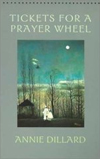 |
Tickets For a Prayer Wheel---poems In this book of poems, I sounded many of the same themes to which I devoted my subsequent prose. Columbia, Missouri: University of Missouri Press, 1974. New York: Bantam, 1975. New York: Harper Colophon, 1986. Middletown, Connecticut: Wesleyan University Press, 2002. |
|
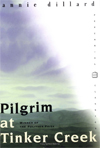 |
Pilgrim at Tinker Creek---nonfiction narrative In 1971 I wanted to try my hand at prose. My journals were full of facts that I used to write Pilgrim at Tinker Creek (1974), a sustained nonfiction narrative about the fields, creeks, woods, and mountains near Roanoke, Virginia. Because I ''named'' its chapters, in the style of 19th-century narratives, many reviewers took it for a book of essays. The book attempted to describe the creator, if any, by studying creation, leading one writer to call me (wonderfully) "one of the foremost horror writers of the 20th Century." New York: Harper's Magazine Press, 1974. New paperback edition, Harper Collins, 2013. |
 1st edition |
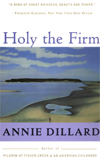 |
Holy the Firm---nonfiction narrative One day while living on Lummi Island, off Bellingham, Washington, I resolved to write about, and make sense of, whatever happened on the island in the next three days. On the second day an island plane crashed. "Oh no," I thought," "must I deal with this again?" "This" was the problem of pain: Why would an omnipotent, omniscient and merciful God allow natural evil to happen? It took me 14 months full-time to write Holy the Firm (1977), 66 typescript pages. Critic Thomas Mallon imagined that it was written in haste. The New York Times Book Review novelist Frederick Buechner called it "a rare and precious book." Other reviewers wondered if I took hallucinogenic drugs. No. New York: Harper and Row, 1977. New York: Bantam, 1978. New York: Harper Colophon, 1984, 1988. Latest text: Harper Perennial, 1998 or 99. |
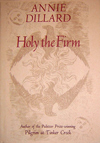 1st edition |
 |
Living by Fiction---unlicensed literary theory In Living by Fiction (1982), I compared surface flatness—then requisite in painting—to attempts to move literature in the same postmodernist direction. I presented my theory about why flattening of character and narrative cannot happen in literature as it did when the visual arts rejected deep space for the picture plane. In the process of writing this book, I talked myself into writing an old-fashioned novel. The result was The Living (1992). | |
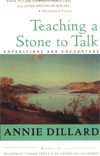 |
Teach a Stone to Talk---short nonfiction narrative essays and travels "The Eclipse" got chosen for Best Essays of the Twentieth Century. "Life on the Rocks: The Galapagos" won the New York Women's Press Club award for its year. "The Weasel" is lots of fun; the much-botched church service is hilarious. There are fourteen essays in all. |
|
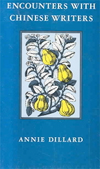 |
Encounters with Chinese Writers---jolly journalism One part of Encounters (1984) takes place in China, where I was part of a delegation of six American writers and publishers representing the United States just after the fall of the Gang of Four. In the second half, I helped host a bunch of Chinese writers (party members). This part includes a trip with Alan Ginsberg and the Chinese writers to Disneyland. I think it's hilarious. UCLA's Perry Link, the then-top China hand, approved the book wholeheartedly in his review. |
|
 |
An American Childhood -- a
memoir about parents, the world of science, and consciousness
New York: Harper and Row, 1987. Harper Colophon, 1988. Tokyo, 1989. Paris, 1990. |
|
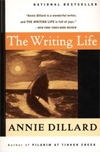 |
The Writing Life---nonfiction "The Writing Life" (1989) is an embarrassing nonfiction narrative fixed somewhat and republished by Harper Perennial 1998. The Boston Globe called it "a kind of spiritual Strunk & White, a small and brilliant guidebook to the landscape of a writer's task." The Chicago Tribune wrote that, "For nonwriters, it is a glimpse into the trials and satisfactions of a life spent with words. For writers, it is a warm, rambling conversation with a stimulating and extraordinarily talented colleague." The Detroit News called it "a spare volume...that has the power and force of a detonating bomb. New paperback edition, Harper Collins, 2013. |
|
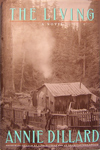 |
The Living---a novel In the process of writing Living by Fiction, I talked myself into writing an old-fashioned novel. The result was The Living (1992). It tells the story of the first European settlers plunked down on the Pacific Northwest coast. (They watched the ship sail away). During the many years of its writing I never allowed myself to read anything that postdated the year I was writing about, nor did I use any anachronistic word. Many readers bought and loved this book---according to my mail (now at Yale). New York: HarperCollins, 1992. Harper Perennial, 1993. Latest text, Harper Perennial, 1999. Paris: Christian Bourgois Editeur, 1995. Rome, 1994. Tokyo, 1994. Berlin, 1995. etc. New paperback edition, Harper Collins, 2013. |
|
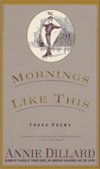 |
Mornings Like This---a kind of remade found poetry Mornings Like This (1995) includes found poems. I took phrases from old books and arranged them into poems, many ironic. Each poem comprises phases from a different book. From a long list I culled from each old book. The poems do not concern the books' topics. A good trick should look hard and be easy. These poems were a bad trick. They look easy and were really hard. Harper Collins, 1995. |
|
 |
For the Time Being---a nonfiction narrative In For the Time Being (1999), as in Holy the Firm, the narrative fills in a grid. The true-story topics in each of seven chapters are "birth, sand, China, clouds, numbers, Israel, encounters, thinker, evil, and now." It tells many short journalistic stories, and a few long ones: Hasidism, Teilhard de Chardin and fossil Homo erectus, the formation of sand, the critical importance of the individual in a world of almost 7 billion individuals, and the absurdity of the doctrines of divine omniscience, divine mercy, and divine omnipotence. I quit the Catholic Church and Christianity; I stay near Christianity and Hasidism. | |
 |
The Annie Dillard Reader
HarperCollins, 1994, 1995. |
|
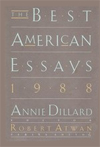 |
Best American Essays of 1988 -- Ed. with Robert Atwan, and intro. by me.
Boston: Houghton Mifflin, 1988. |
|
 |
Modern American Memoirs (1996, ed. with Cort Conley) | |
 |
The Maytrees---novel The Maytrees (2007) is a short, spare novel of lifelong love between husband and wife. They live in Provincetown, Cape Cod, beginning after World War II. Many readers prefer The Maytrees---with its spare prose, good story, and lack of metaphysics---to Pilgrim at Tinker Creek. (Other readers think that the prize necessarily goes to the best book.) It was one of the New York Times Book Review's Top Ten Books of the Year (2007) and was a finalist for the Pen/Faulkner Award, 2008. New York: HarperCollins, 2007. Part appeared previously in Harper's. |
|